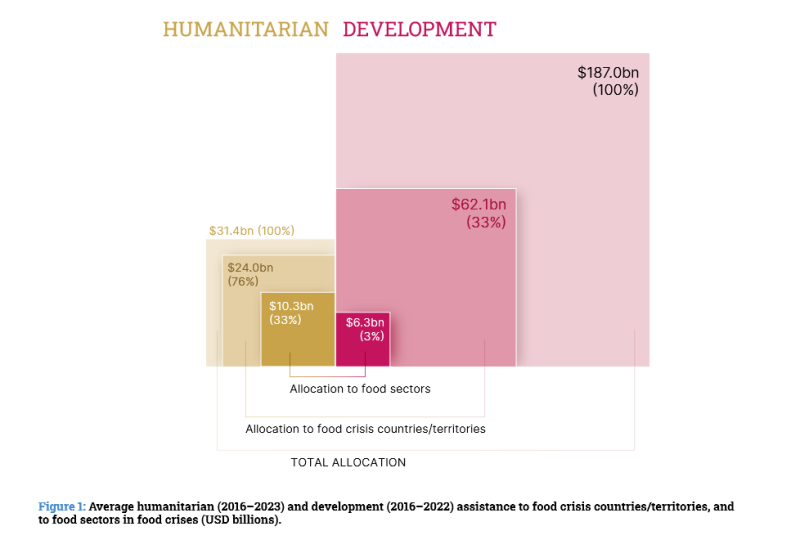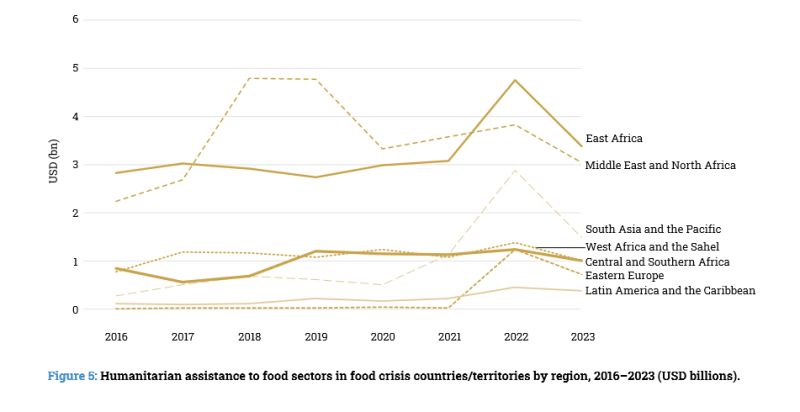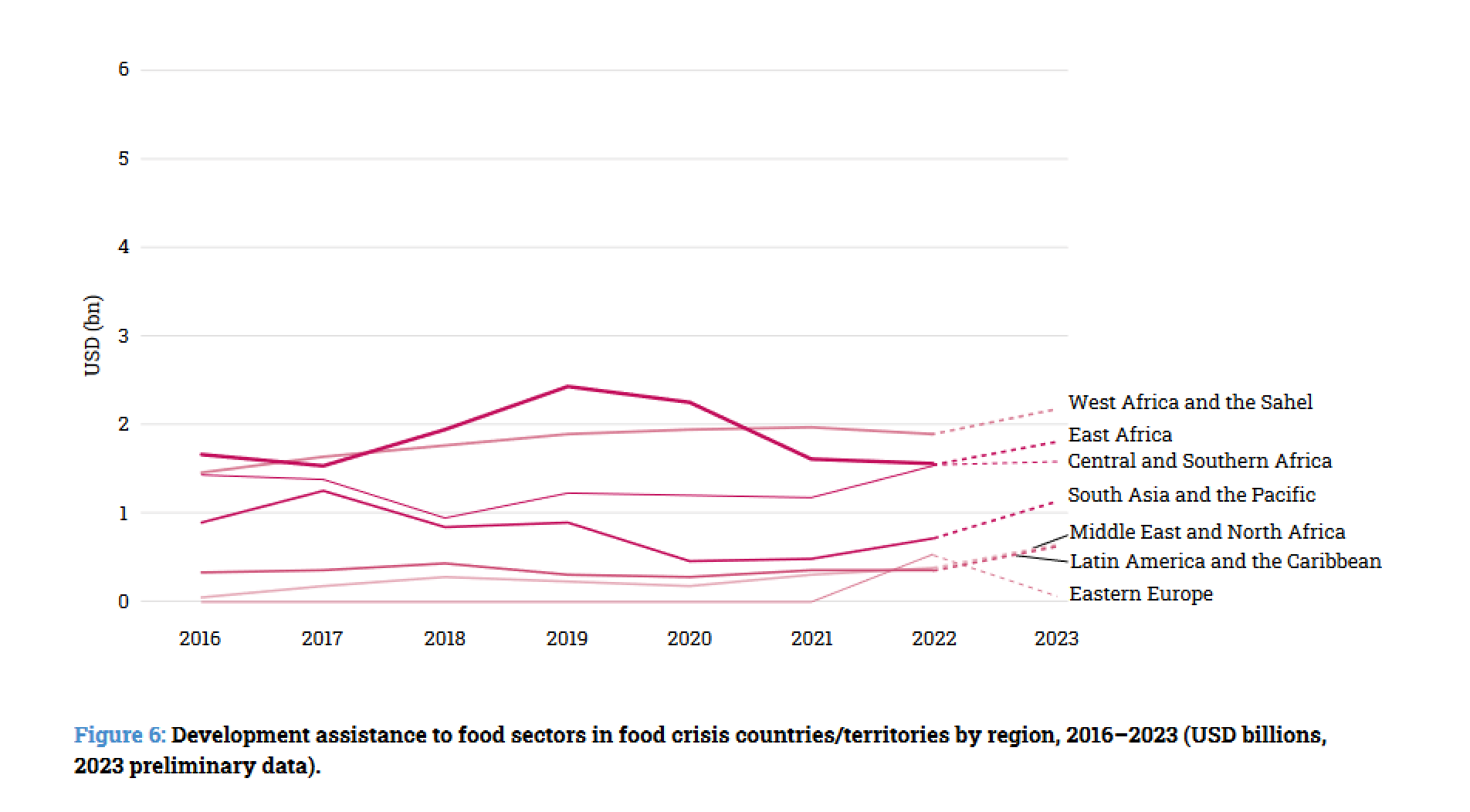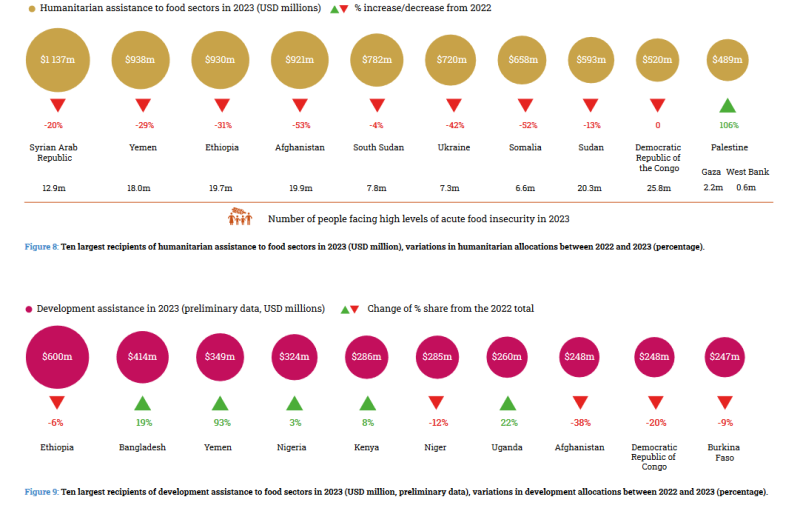Context:
The Financing Flows and Food Crises report is an annual publication that provides a comprehensive overview of food sectors financing flows in food crises, and insights into how international financial allocations address acute food insecurity. The report serves as a companion piece to the Global Report on Food Crises (GRFC), by providing an evidence-based snapshot of trends in humanitarian and development financing to food sectors in food crisis contexts.
Key findings:
In 2023, humanitarian assistance saw an overall decrease of 19 percent compared to 2022. This decline was even more significant for allocations to food sectors in food crises (down 30 percent). Despite the decrease between 2022 and 2023, the long-term trend of humanitarian assistance remains positive (up by 56 percent since 2016).
While development allocations to countries/territories facing food crises are significantly larger than humanitarian assistance, on average only 3 percent (USD 6.3 billion) of global development funding goes to food sectors, compared to 33 percent (USD 10.3 billion) of global humanitarian assistance.


After the seven-year high in humanitarian financing observed in 2022, allocations decreased across all regions in 2023 but remained above their 2016–2022 average, except for the Middle East and North Africa (MENA) region, where allocations remained almost USD 1 billion below the average. As for development assistance, global allocations to all regions increased in 2023, except for Eastern Europe.


In 2023, the ten largest recipients of humanitarian disbursements absorbed 70 percent of all allocations to food sectors in food crises. While for development financing, the ten largest recipients were all countries facing protracted food crises and absorbed 40 percent of development allocations.

The changes in humanitarian assistance from 2022 to 2023 did not significantly impact the proportion allocated to the three food-related sectors. Since 2016, food assistance has consistently received around 85 percent of the aid, while nutrition has remained at around 12 percent, and emergency agriculture has stayed at about 3 percent.
The main development food sectors have retained their relative weight over the years, even if the increase in overall development funding in 2023 is considered. Agriculture absorbed over 50 percent of the allocations between 2016 and 2023, development food assistance around 14 percent, while rural development and basic nutrition are at around 10 percent each. The relatively less funded food sectors have increased from 3 percent in 2016 to 12 percent in 2023 – this is mostly due to increases in forestry and household food security programmes.
In protracted major food crises, humanitarian assistance is the main source of food sector financing, while development financing remains marginal. In the 19 contexts affected by major food crises over the past eight years, almost half of all humanitarian funding was directed to food sectors. Meanwhile food sectors accounted for just 13 percent of total development spending in the 19 contexts.
Warnings of a deterioration in food security outcomes do not necessarily translate into significant changes in humanitarian allocations to food sectors. Several factors can also affect the disbursements, such as the operational and political environment of each food crisis.
| Year of publication | |
| Publisher | Global Network against Food Crises (GNAFC) |
| Geographic coverage | Global |
| Originally published | 06 Feb 2025 |
| Related organisation(s) | FAO - Food and Agriculture Organization of the United NationsWFP - World Food ProgrammeWorld BankUNICEF - United Nations Children's FundUNHCR - United Nations High Commissioner for RefugeesEC - European CommissionUSAIDIFAD - International Fund for Agricultural Development |
| Knowledge service | Metadata | Global Food and Nutrition Security | Food security and food crisesClimate extremes and food security Nutrition | Extreme weather eventCountries affected by conflictFood price crisis |
| Digital Europa Thesaurus (DET) | humanitarian aidcrisis managementfood aidaid systemaid policyAid to agriculture |
